Tiger Lake-H Tested: We Benchmark Intel's Top-End 8-Core i9-11980HK
10nm H-Series is here.
Intel is starting to get its legs again. The company, which initially had issues with its 10nm chips, has released its first eight-core, 10nm Tiger Lake-H processors that are ready for gaming and high-end productivity notebooks.
For its 10th gen chips, Intel used a 10nm process ("Ice Lake") for ultrabooks but used a 14nm chip ("Comet Lake") for these enthusiast machines. Now, we have time to see what Intel's 10nm SuperFin chips can do on the high end. Like the U-series Tiger Lake chips, these use Willow Cove execution cores paired with a UHD Graphics 750 engine that’s powered by Intel's Xe architecture.
It comes at a crucial time. AMD's Ryzen 5000 series ("Cezanne," on a 7nm process) has proven powerful and, among gamers, popular. During current hardware shortages, some of the best gaming laptops have been nearly impossible to find. Intel claims that it has already shipped more than 1 million of its chips to its partners and that it will come in more than eighty different laptop designs.
The 11th Gen H-series processors include Thunderbolt 4 (and USB 4) and Resizable Bar support, and are notably Intel's first eight-core laptop chips that work with PCIe 4.0 SSDs. AMD's competing Zen 3 mobile chips are still on PCIe 3.0.
A lot is riding on Tiger Lake H's success. Intel has already called its 11th generation the "world's best gaming laptop processors," and now, with the help of a sample unit, we’ve had a chance to see if those claims ring true.
How We Tested Tiger Lake i9
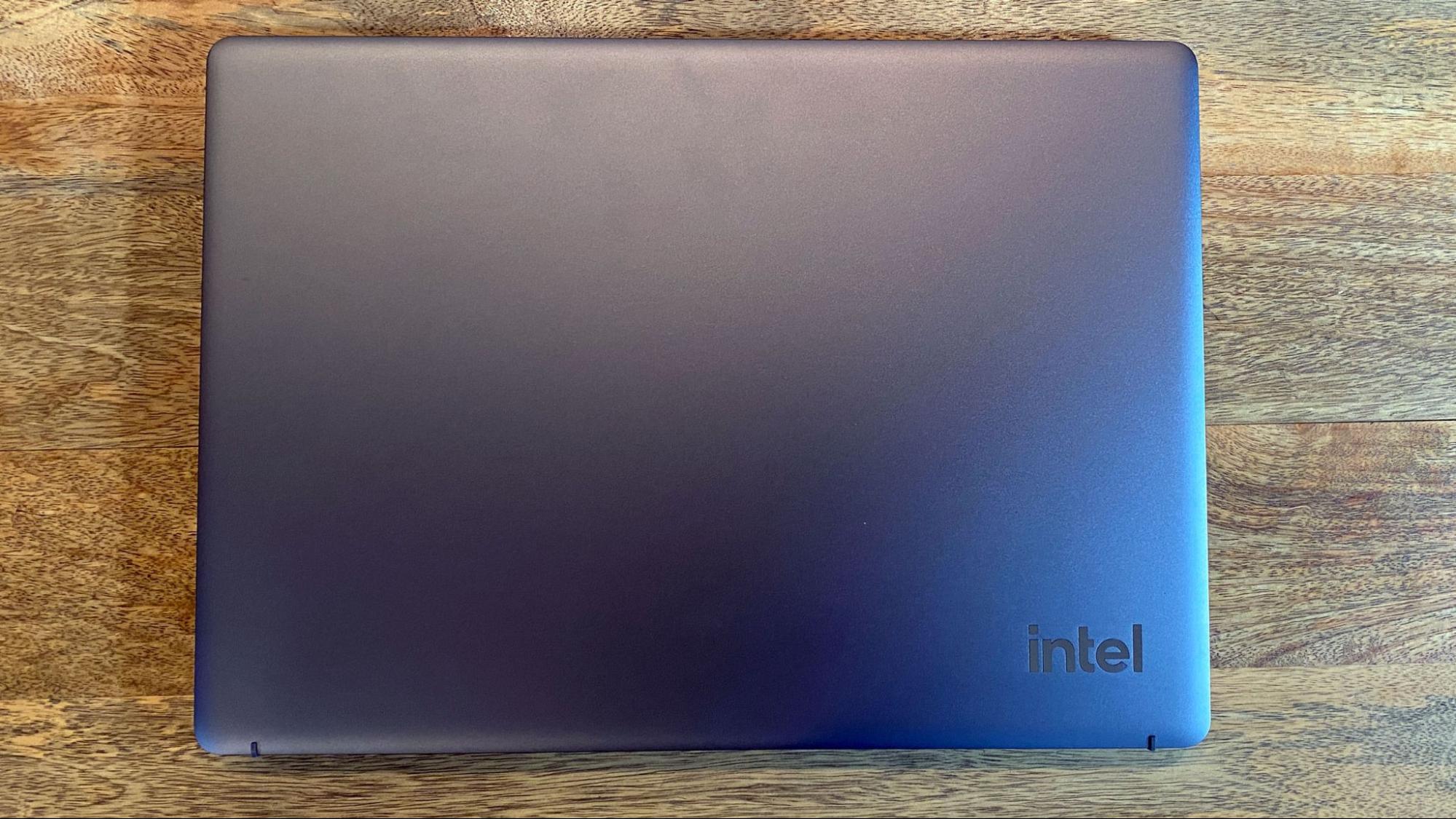

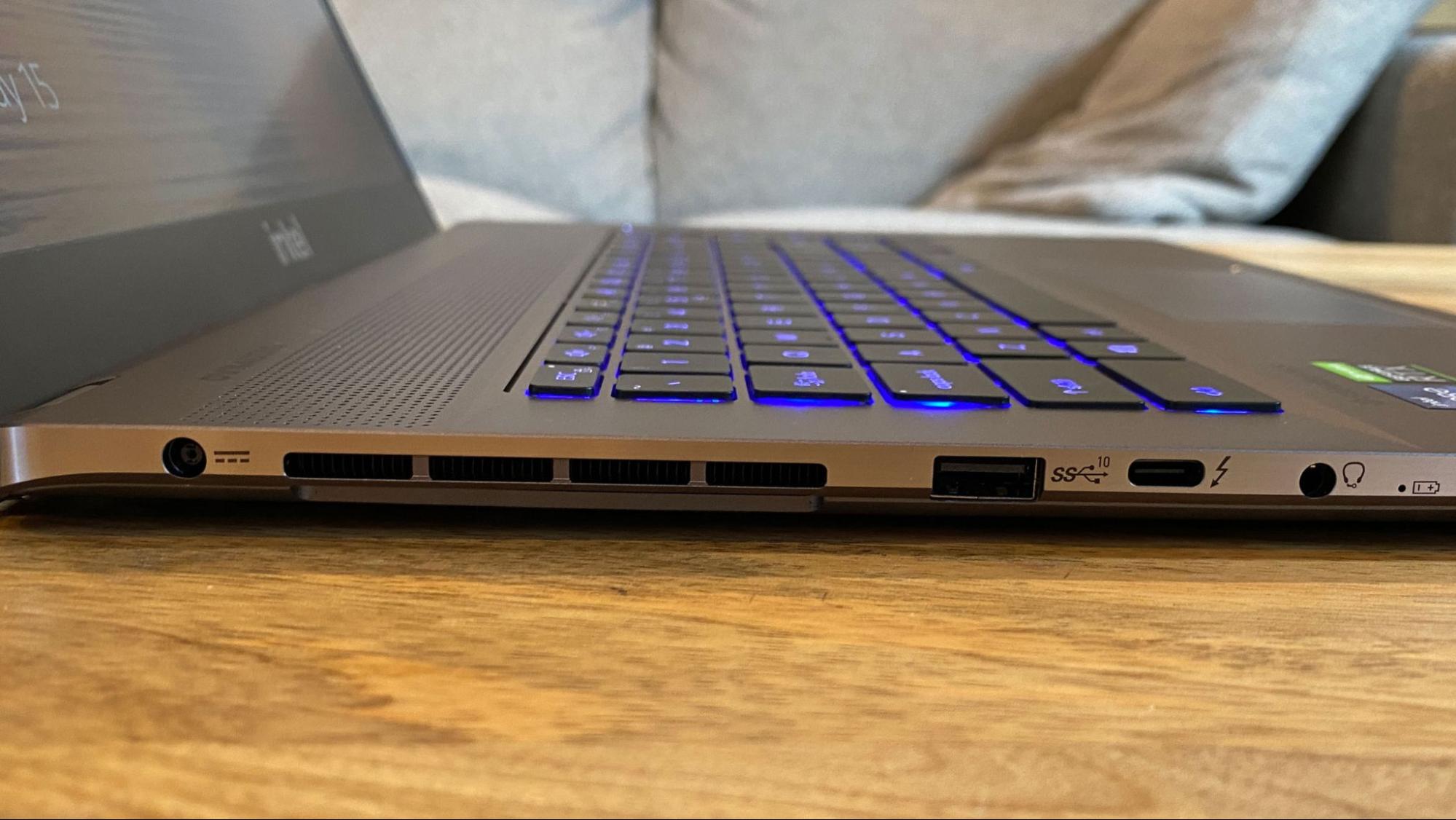

Our Tiger Lake-H testing was performed on an Intel-branded sample "white box" system, similar to our early testing of Tiger Lake-U and Ice Lake. This isn't a review of the Intel Core i9-11980HK processor inside so much as a performance preview of what you can expect from upcoming systems that will be available to buy. Our full reviews will come when we see the i9-11980HK and other 11th Gen CPUs in computers that are on sale.
Intel loaned reviewers these systems with the knowledge that they are pre-production systems that aren't necessarily representative of final systems, which may have more finished drivers.
Unlike previous Intel sample systems, this one couldn't toggle between TDPs. Many of Intel's 11th gen processors will be configurable by the manufacturer, ranging from 35 to 65W (the Core i9-11980HK is a 65W, overclockable processor that peaks at 110W (PL2). In HWInfo, our unit showed a PL1 of 65W and a PL2 of 109W.
We did our testing on the suite we use to test gaming laptops to get an idea of where something specced similar to this sample system might fall. We had a limited amount of time with the system, so we could only run some tests. Some, like battery life, are more important on actual systems that will be on sale than this early sample.
Intel Reference Design for Tiger Lake i9 and Competitors
The Tiger Lake-H i9 reference design came with the following specifications:
| CPU | Intel Core i9-11980HK (8C/16T, up to 5.0 GHz) |
| GPU | Nvidia GeForce RTX 3060 Max-Q (6GB GDDR6) at 65W, Intel UHD Graphics |
| RAM | 32GB DDR4-3200 (16x2) |
| Storage | 2x 512GB Phison SM280512GKBB4S-E162 PCIe Gen 4 SSD |
| Display | 16-inch, 2560 x 1600 (16:10) |
| Networking | Killer Wi-Fi 6E ax1675X |
| Ports | 2x Thunderbolt 4, 2x USB Type-A, microSD card reader, 3.5mm headphone jack |
| Battery | 90 WHr |
| Operating System | Windows 10 Pro |
Yes, Intel's sample system paired its top-end GPU with a mid-range Nvidia GPU. It's an odd pairing on paper, but one that allows for slim systems. Intel claims that this will enable "thin enthusiast" laptops, which fall in between ultraportable notebooks with its H35 processors and the big, thick machines that include the most intensive graphics cards.
From our reviews database, we chose to compare a number of different laptops depending on the task. For gaming, we broke out the Acer Predator Triton 300 SE with a 35W i7-11375H and the Alienware m15 Ryzen Edition R5 with a Ryzen 7 5800H. Both of these also use RTX 3060 GPUs, like the reference system.
For our productivity benchmarks, we also included some other, bigger systems that may have more powerful GPUs to compare against a range of processors, including the Ryzen 9 5900HX in the Asus ROG Strix Scar 17 G733; the Intel Core i9-10980HK in the Alienware m17 R4; and the 35W Ryzen 9 5980HS in the Asus ROG Flow X13.
| Header Cell - Column 0 | Acer Predator Triton 300 SE | Alienware m15 Ryzen Edition R5 | Asus ROG Strix Scar 17 G733 | Alienware m17 R4 | Asus ROG Flow X13 |
|---|---|---|---|---|---|
| CPU | Intel Core i7-11375H | AMD Ryzen 7 5800H | AMD Ryzen 9 5900HX | Intel Core i9-10980HK | AMD Ryzen 9 5980HS |
| GPU | Nvidia GeForce RTX 3060 Max-Q, 75W TGP | Nvidia GeForce RTX 3060 125W TGP | Nvidia GeForce RTX 3080, 130W | Nvidia GeForce RTX 3080 | AMD Radeon Graphics (integrated) |
| RAM | 16GB DDR4-3200 | 16GB DDR4-3200 | 32GB DDR4-3200 | 32GB DDR4-2933 | 32GB LPDDR4x-4266 |
| Storage | 512GB M.2 PCIe NVMe SSD | 512GB M.2 PCIe NVMe SSD | 2x 1TB M.2 NVMe SSD | 512GB Boot, 2TB (2 x 1TB RAID 0) SSD | 1TB M.2 2230 NVMe SSD |
| Display | 14-inch, 1920 x 1080, 144 Hz IPS | 15.6 inch, 1920 x 1080, 165Hz, IPS | 17.3-inch, 1920 x 1080, 360 Hz, IPS | 17.3-inch, 1920 x 1080, 360 Hz | 13.4-inch, 3840 x 2400, 16:10, 60 Hz, touch |
And here's how the CPUs all stack up on paper:
Get Tom's Hardware's best news and in-depth reviews, straight to your inbox.
| Header Cell - Column 0 | Cores / Threads | Process Node | Base Frequency | Max Turbo Frequency | TDP |
|---|---|---|---|---|---|
| Intel Core i9-11980HK | 8/16 | 10nm SuperFin | 2.6 GHz | 5.0 GHz | 45 - 65 W |
| Intel Core i9-10980HK | 8/16 | 14nm | 2.4 GHz | 5.3 GHz | 45 - 65 W |
| Intel Core i7-11375H | 4/8 | 10nm SuperFin | 3.3 GHz | 5.0 GHz | 28 - 35W |
| AMD Ryzen 7 5800H | 8/16 | 7nm FinFET | 3.2 GHz | 4.4 GHz | 35 - 54W |
| AMD Ryzen 9 5900HX | 8/16 | 7nm FinFET | 3.3 GHz | 4.6 GHz | 35 - 54W |
| AMD Ryzen 9 5980HS | 8/16 | 7nm FinFET | 3.0 GHz | 4.8 GHz | 35W |
Productivity Performance of Tiger Lake i9
We started out with our productivity suite to test the Core i9-11980HK to its 10th Gen counterpart, the highest-end Intel H35 processor and a series of AMD Ryzen competitors.

On Geekbench 5, the Tiger Lake-H system started strong, pushing the highest single-core (1,649) of the bunch and beating the next highest multi-core score by more than 1,000 points (9,254). The next closest was the AMD Ryzen 9 5900HX in the Asus ROG Strix Scar 17 G733, which also had 32GB of RAM.
The Core i9-10980HK, the 10th Gen chip from Intel, was in a close third on multi-core, though in single-core other Ryzen laptops surpassed it.
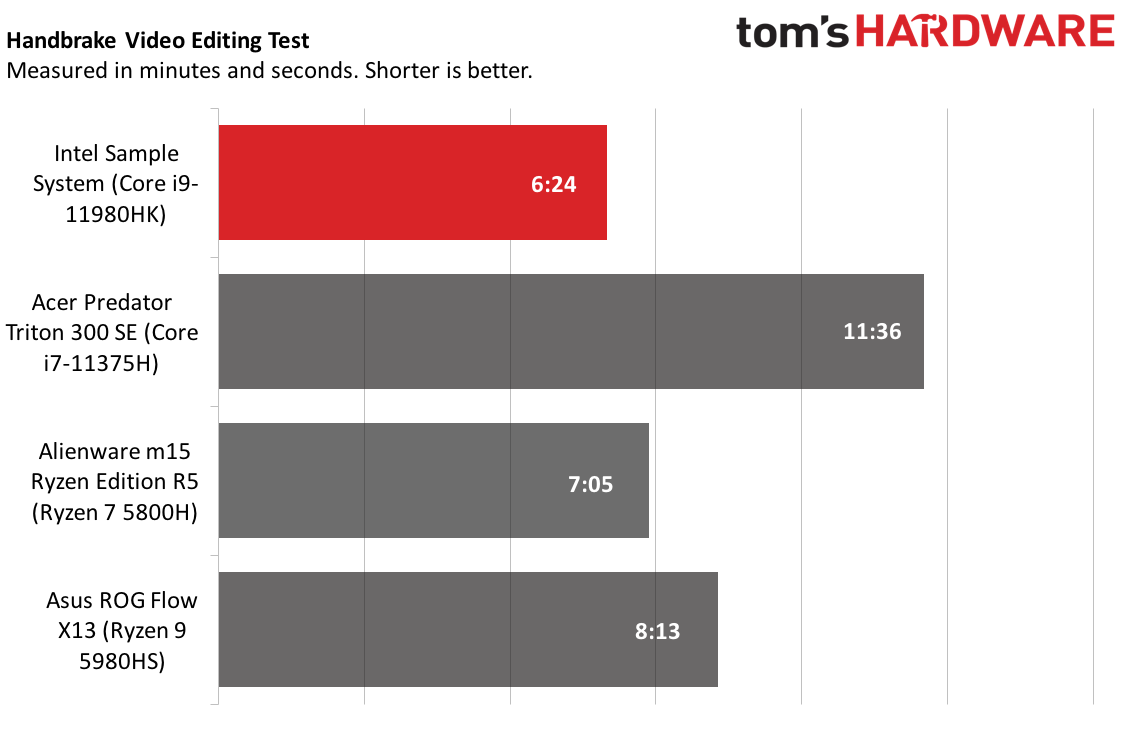
The Intel sample system was also the fastest system to complete our Handbrake test, which transcodes a 4K video to 1080p (with one caveat: we removed laptops with far more powerful GPUs, which could have some effect. If you left in the Ryzen 9 5900HX, it was faster at 6:11 in the Asus ROG Strix Scar 17 G733).
It was (unsurprisingly) significantly faster than the 35W Core i7, and also ahead of the Ryzen 7 5800H and 35W Ryzen 9 59080HS.
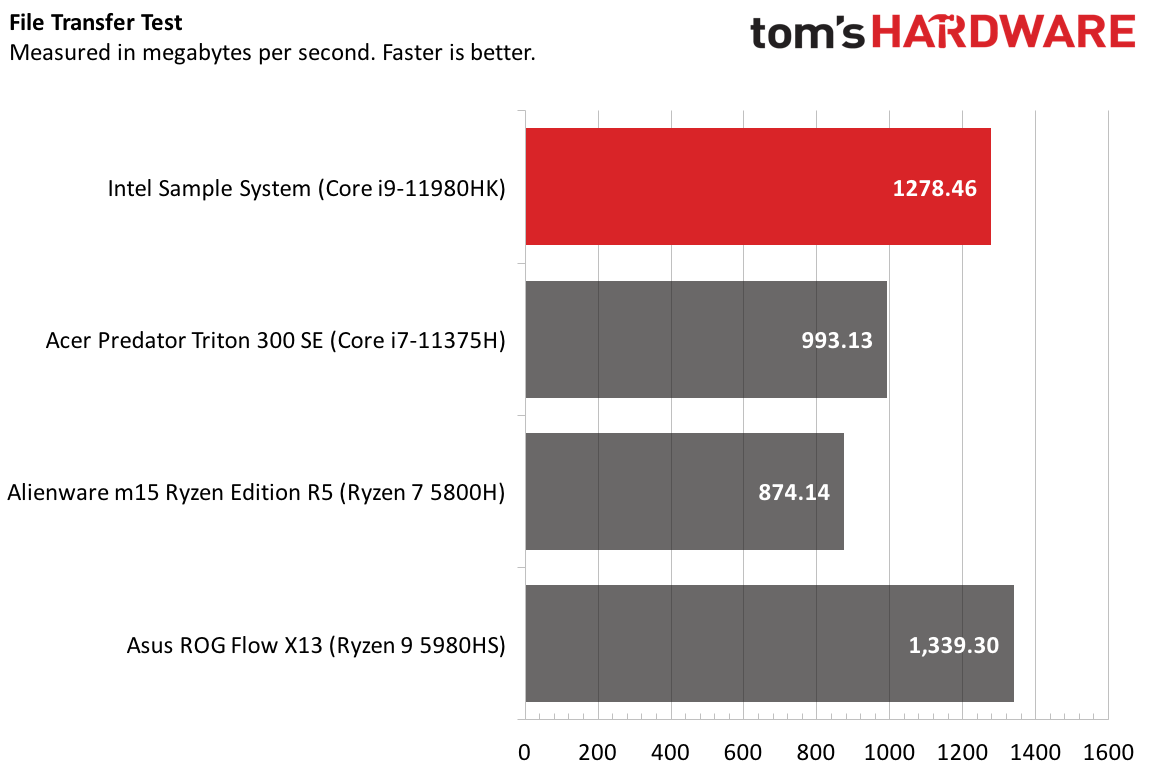
The Intel sample system contained a pair of 512GB Phison PCIe Gen 4 SSDs, which the Core i9-11980HK can take advantage of. It was one of the speedier laptops in our test pool, but the Asus ROG Flow X13 was actually a little bit faster in our 25GB file transfer test.
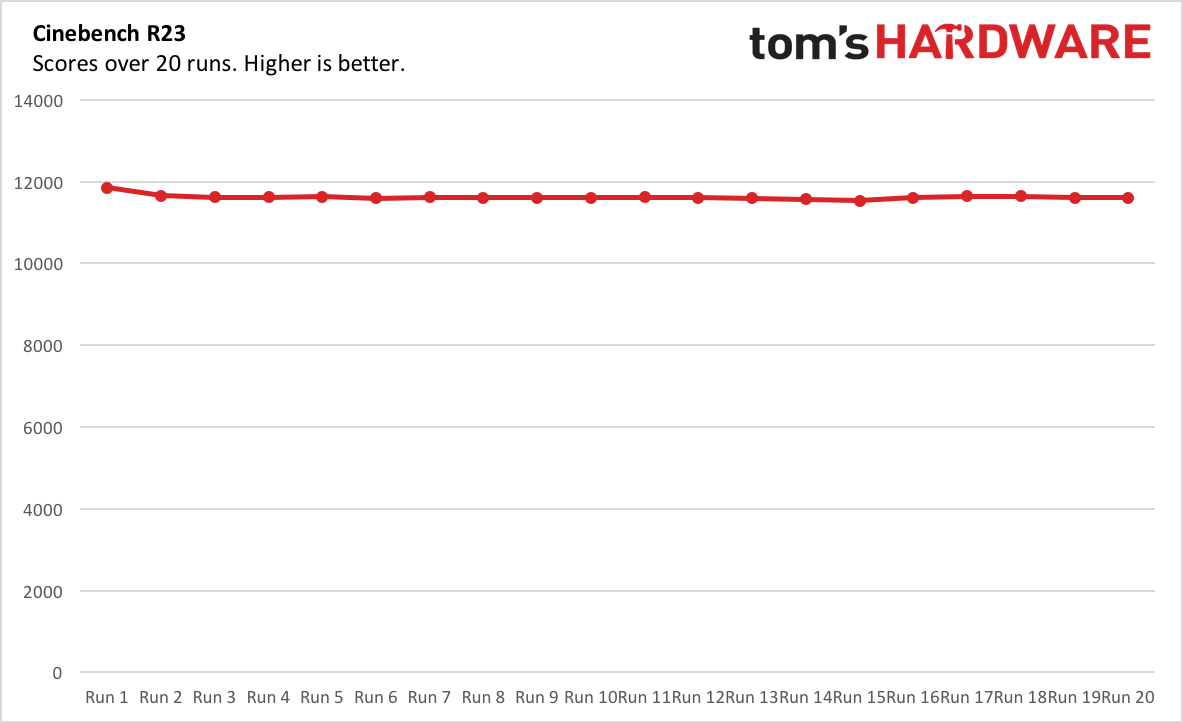
To check stability over a longer duration, we ran Cinbench R23 for 20 runs. The cooling, which was exceptionally loud during all of the tests (and sometimes while the sample system was doing absolutely nothing) kept it stable.
It started at a high of 11,846.31 while largely settling in the 11,600 range. During the Cinebench stress test, the CPU ran at an average of 3.5 GHz and an average temperature of 85.77 degrees Celsius (186.39 degrees Fahrenheit). While the chart looks largely stable, the monitoring tool HWinfo reported that the CPU was being thermally throttled for the majority of the test. This is the downside of putting a high-wattage processor in a slim system, and also explains the constant fan noise.
Gaming and Graphics Performance of Tiger Lake i9
In this system, Intel paired its top-of-the-line mobile processor with an RTX 3060 Max-Q. It's a questionable decision for this kind of performance preview, as our first impression didn't give us the chance to see what happens when this chip is used with a more powerful graphics card that would take full advantage of its capabilities. So our test pool here includes other laptops with an RTX 3060, either full or Max-Q.
On most of the benchmarks we ran, this thin and light notebook performed almost identically to what you would expect from Intel's 35-watt Tiger Lake H processors that were launched earlier this year. That is, at 1080p. We also ran the tests at the laptop's native 2560 x 1600 resolution.
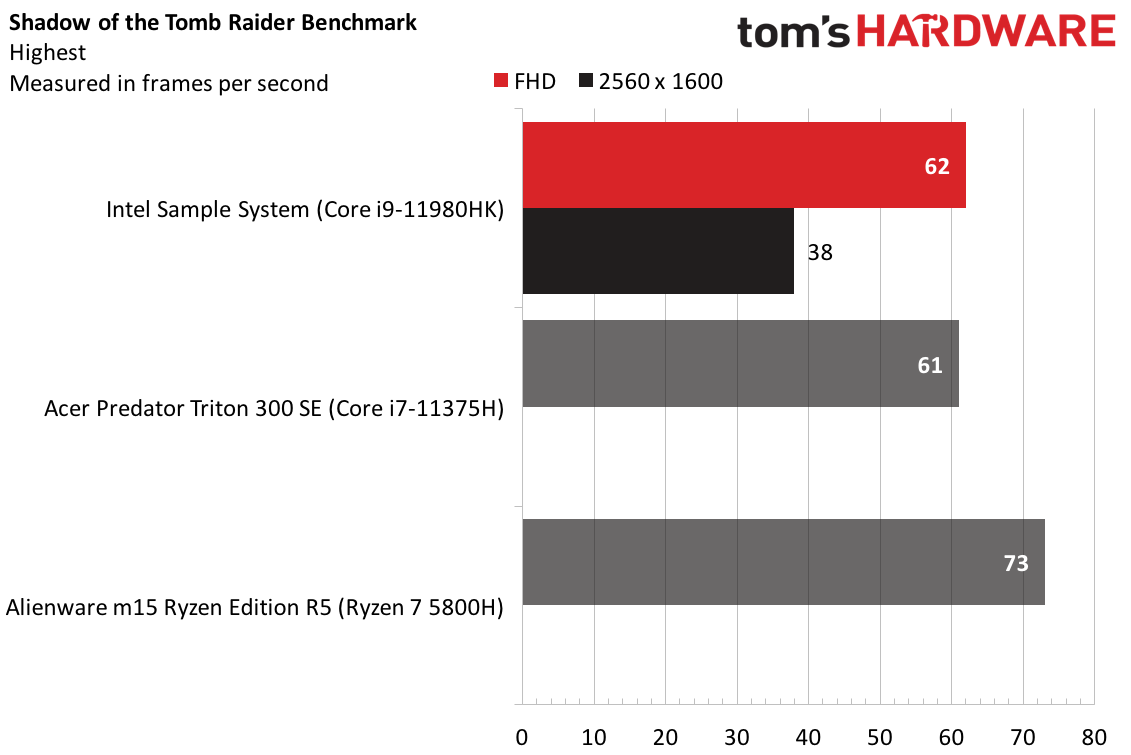
On Shadow of the Tomb Raider (highest settings), the Intel sample system ran the benchmark at 62 frames per second, within one frame of the Acer Predator Trion 300 SE with H35. The Alienware m15 Ryzen Edition R5 with a full RTX 3060 Max-Q won out at 73 fps.
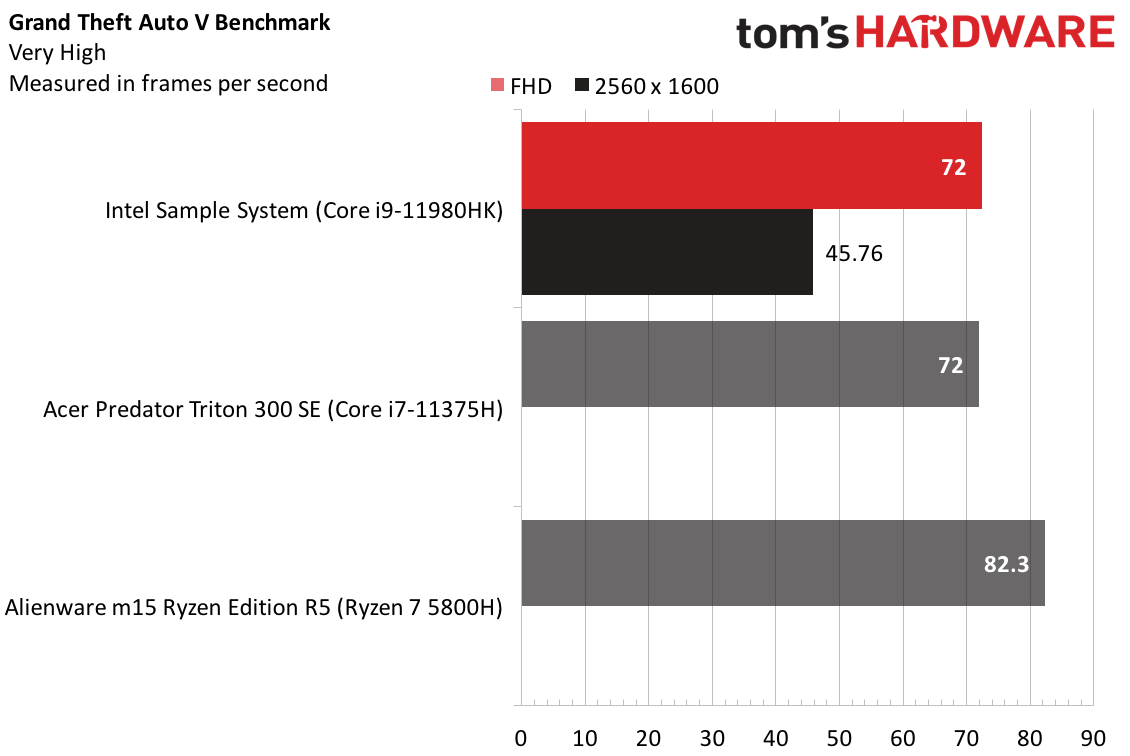
We saw a very similar pattern on Grand Theft Auto V (very high settings). Intel's system matched the Acer but fell behind the Alienware. On both Shadow of the Tomb Raider and GTA V, the Intel system was still playable above 30 fps at 2560 x 1600 on the same settings.
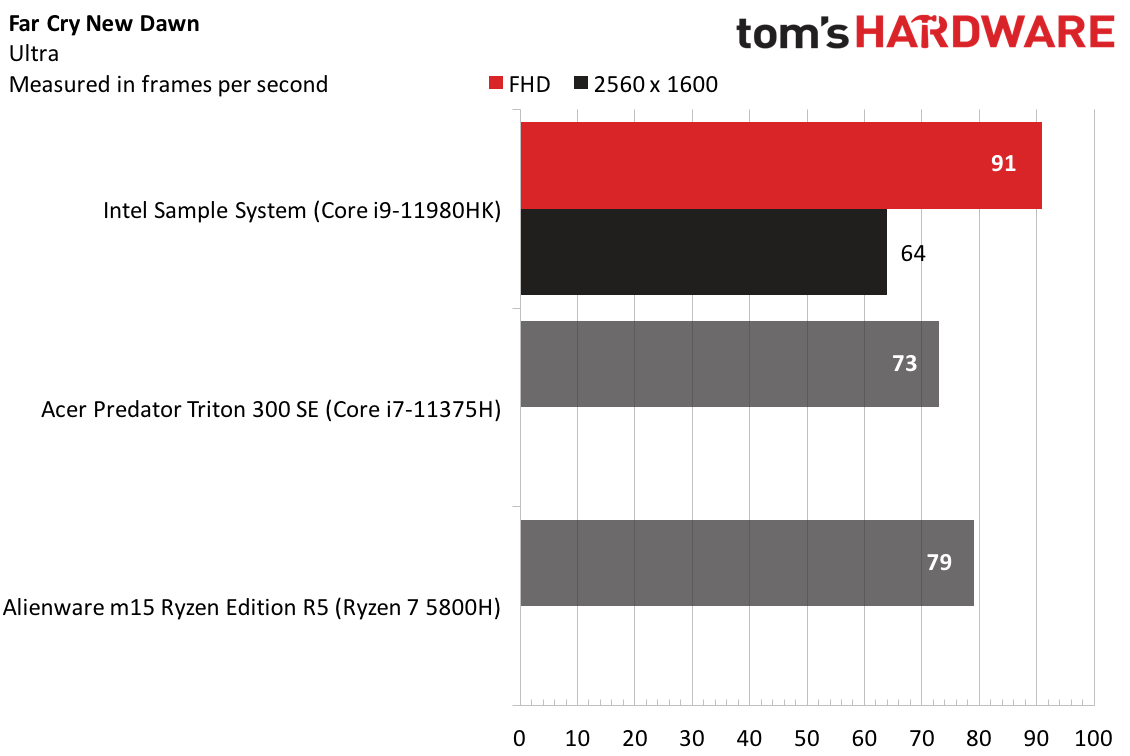
Tiger Lake-H finally had its moment on Far Cry New Dawn (ultra settings), running at 91 fps, beating out both the Predator (73 fps) and AMD-based Alienware (79 fps) at 1080p. At native resolution, the sample system was still over 60 fps.
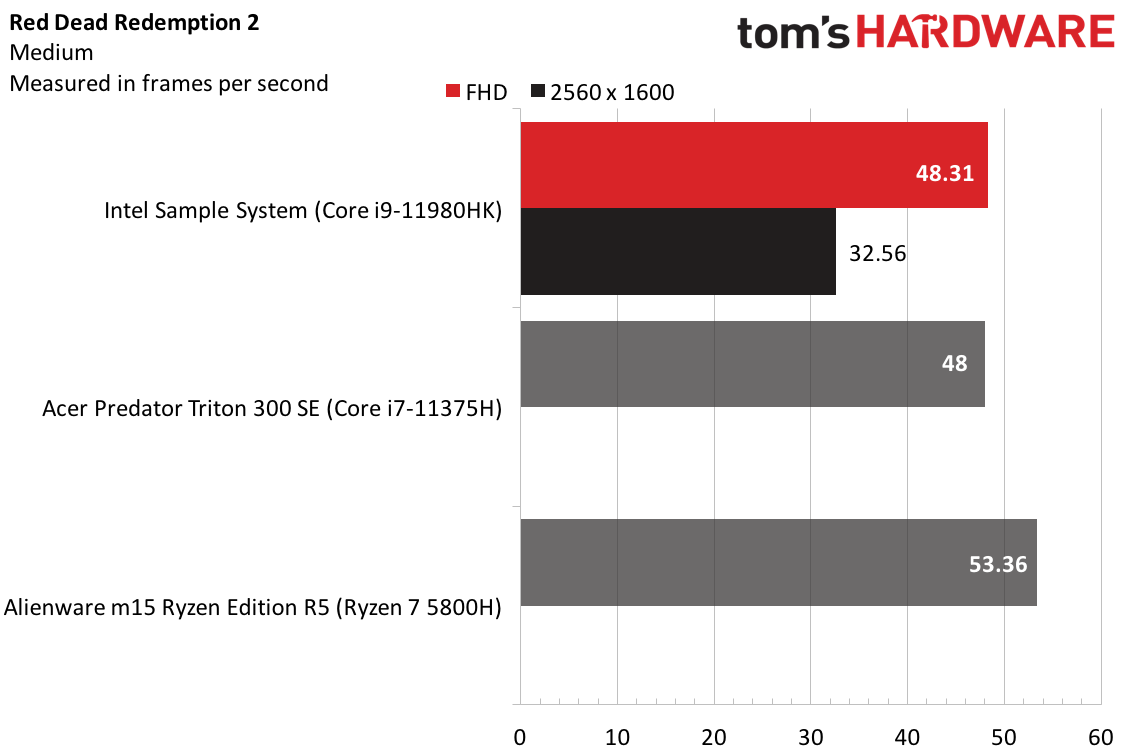
But on Red Dead Redemption 2 and Borderlands 3, we were back to the same old tale, coming extremely close to the H35 laptop. On RDR 2's medium settings, it ran at 48 fps at 1080p and 33 fps at 2560 x 1440.
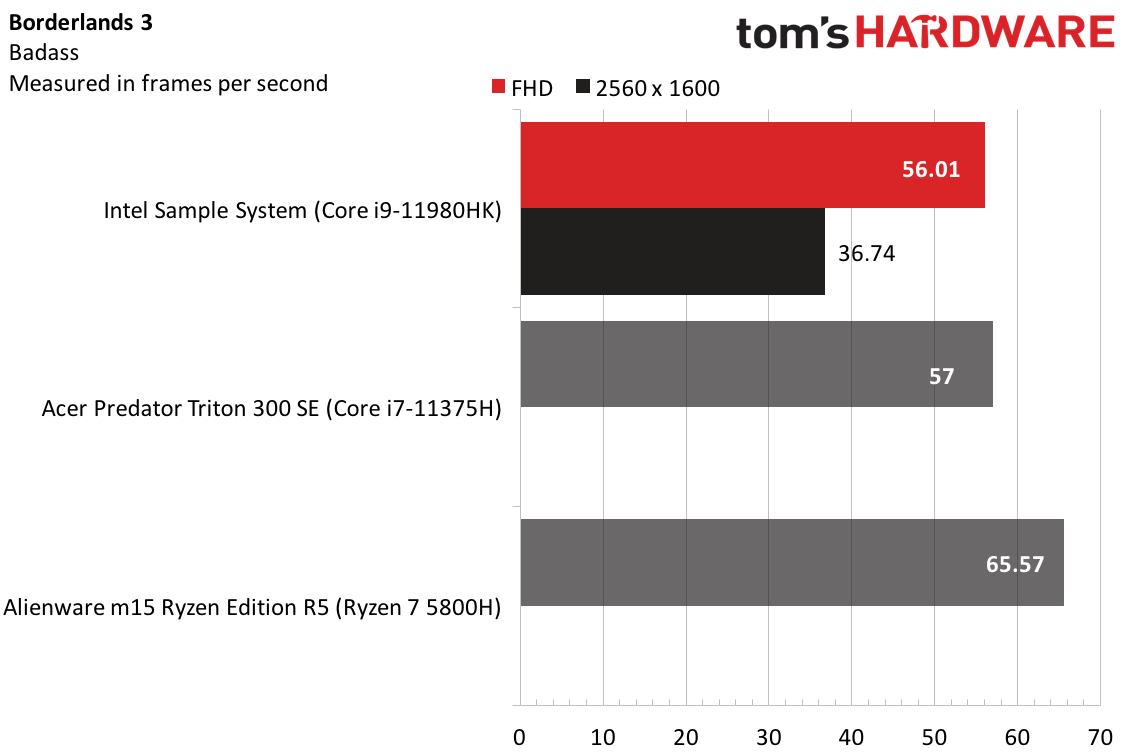
On Borderlands 3's "badass" quality settings, the game ran at 56 fps at 1080p, falling about 10 frames behind the Alienware. Intel's sample system ran the game at 37 fps at 2560 x 1600.
Lastly, we ran the Metro Exodus gauntlet that we run in our laptop review. We have laptops play through the benchmark 15 times on the RTX preset (1920 x 1080) to simulate a half-hour of gaming. Intel's CPU ran at an average of 3.38 GHz with an average temperature of 64.71 degrees Celsius (148.48 degrees Fahrenheit). There was some throttling, but not as often as during the Cinebench R23 stress test. The GPU ran at an average of 1,188.23 MHz and 64.21 degrees Celsius (147.58 degrees Fahrenheit).
Cooling Tiger Lake i9

Unlike with some previous early Intel samples, we were allowed to crack this one open to show it to you.
The laptop has three fans, while even most gaming laptops stick to two larger ones. That may explain the decibels. But what's also fascinating is that the motherboard in the reference platform has been placed effectively upside down. This means that we can't see the full cooler, including the heat pipes. That would require far more disassembly.
There are still serviceable parts, but they are connected to the edge of the board. Notably, there's only one 512GB SSD that's easily accessible. The other one must be on the other side of the motherboard.
Impressions of Tiger Lake i9
As always, it's extremely difficult to get a complete picture of how high-end, Tiger Lake-H chips will run in laptops that OEMs will start selling today. Our testing was done under extremely limited time, and only used one new 11th Gen H-series chip.
To complicate things, this reference design is meant to represent a new "thin enthusiast" sector for Intel, which meant we couldn't see how the Core i9-11980HK will perform at its best, in a thicker laptop with more elaborate cooling. Of course, every laptop is unique, so the processors may perform slightly differently based on size, cooling and other factors. We hope to be able to see a bigger, flagship gaming system with this processor for a fuller idea soon.
In productivity testing, our early benchmarks show a leap for Intel and its 10nm SuperFin process, especially in multi-core workloads. But AMD's best, the Ryzen 9 5900HX still puts up a fight in some areas.
In gaming, we'll really have to wait. What we now expect from finalized thin systems is that they won't run games much differently from H35 variants unless those titles really hit the CPU hard.
As usual, the best way to truly tell is when we start testing laptops with a Tiger Lake-H that you can actually buy. As those hit our labs, we'll see a wider variety of laptop designs and the full range of 11th Gen H-series processors.
Andrew E. Freedman is a senior editor at Tom's Hardware focusing on laptops, desktops and gaming. He also keeps up with the latest news. A lover of all things gaming and tech, his previous work has shown up in Tom's Guide, Laptop Mag, Kotaku, PCMag and Complex, among others. Follow him on Threads @FreedmanAE and BlueSky @andrewfreedman.net. You can send him tips on Signal: andrewfreedman.01
-
Phaaze88 -Gives clearance to take the hood off.Reply
-Motherboard isn't upside down like it usually is, so all you get is backside, LOL.
That felt somewhat troll-y.
How many laptop models sporting this chip are going to get gimped below the 65w(that's high for a laptop) TDP? Combined with w/e the gpu is, that won't be nothing nice. -
dehjomz Seems that Intel is coming back… competition is about to heat up. I wonder how Alder Lake will compare? AMD may be in trouble until Zen 4 drops. Only time will tell.Reply -
excalibur1814 "also explains the constant fan noise. "Reply
One day, it would be nice for an oem to make a nearly silent/quiet gaming laptop. Heck, gimp on everything but the cooling. -
weilin Replyexcalibur1814 said:"also explains the constant fan noise. "
One day, it would be nice for an oem to make a nearly silent/quiet gaming laptop. Heck, gimp on everything but the cooling.
That already exists... To maximize all the heatsinks and fan sizes, the motherboard ends up being around 12" x 10". The cooling solution for the GPU and CPU would be independent of each other and thus the GPU would be easily user swappable too! (Bonus, the board has up to 7 swappable expansion ports that's PCIe compatible for whatever else you fancy!)
I'm afraid this is more or less the nature of the beast, without giant towering coolers fan noise will forever be an issue... To overcome this would also end up being 6+" thick laptop. Or basically a mini desktop with a integrated screen on the case... -
FakeMike This does not look good for Intel at all. Its flagship loses in most games to an AMD 45W TDP CPU. Even the margins in benchmarks that it manages to pull ahead in are not convincing if you consider that they are about 10% better for a part that consumes at least 44% more power (which is not the case because of 110W L2 power) and will be undoubtedly very expensive offering. The efficiency is even worse when compared to a 35W HS series Ryzen, which is not far off. Naturally we need more tests of the 45W Intel CPUs to be able to draw more meaningfull conclusions.Reply -
hotaru.hino Reply
So basically one of those Clevo desktop replacement computers.excalibur1814 said:"also explains the constant fan noise. "
One day, it would be nice for an oem to make a nearly silent/quiet gaming laptop. Heck, gimp on everything but the cooling. -
Phaaze88 I don't browse too many laptop threads, but ~man... to heck with how it performs, 65w BASE TDP is a lot on a cpu.Reply
People already complain about Intel cpu thermals and noise in 35 and 45w packages, like WTH.
This cpu should not be found in ANY kind of laptop that cuts cost on cooling - I wouldn't even think to look at one under 3500USD - maybe 3000.
That's not even including the gpu, with this cpu I believe the heatsinks should be separated, not shared, which many cheaper models do.
-quiet, or close to it
-excellent cooling
-great performance
-lightweight
-affordable, or not as hard on the bank
At best, one can do 4 out of 5. -
hotaru251 geekbench intel wins barely over amd...which is also running nearly 600mhz slower than the intel... totally fair right? (yet u removed stronger gpu as it wasnt fair in the handbrake test....)Reply
can't be "fair" in some and not all i mean you are already not showing how well ryzen can do with taking time to fiddle with RAM timings.
